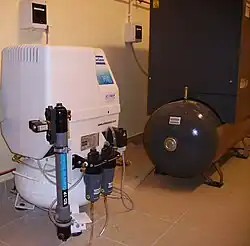Ionic liquid piston compressor
An ionic liquid piston compressor, ionic compressor or ionic liquid piston pump is a hydrogen compressor based on an ionic liquid piston instead of a metal piston as in a piston-metal diaphragm compressor.[1]

Principle
An ionic liquid compressor takes advantage of two properties of ionic liquids—their virtually non-measurable vapor pressures and large temperature window for the liquid phase—in combination with the low solubility of some gases (e.g. hydrogen) in them. This insolubility is exploited by using the body of an ionic liquid to compress hydrogen up to 1000 bar (14,500 psi)[2] in hydrogen filling stations. Linde's ionic liquid compressor reduced the number of moving parts from about 500 in a conventional reciprocating compressor down to 8.[3]
Many seals and bearings were removed in the design as the ionic liquid does not mix with the gas. Service life is about 10 times longer than a regular reciprocating compressor with reduced maintenance during use, energy costs are reduced by as much as 20%. The heat exchangers that are used in a normal piston compressor are removed as the heat is removed in the cylinder itself where it is generated. Almost 100% of the energy going into the process is being used with little energy wasted as reject heat.[4]
Not to be confused with the ion pump or the ionic liquid ring pump.
History

After the renewed interest in ionic liquids, research was done by proionic, an enterprise in the spin-off center "ZAT Center for applied Technology" of the University of Leoben.[5][6] The system was demonstrated at Zemships.[7][8]
See also
References
- New developments in pumps and compressors using Ionic Liquids Dead link!
- Linde AG: Linde starts small-series production for hydrogen fuelling stations
- Ionic liquid compressor
- "Linde Develops Ionic Compressor for More Efficient Compressed Hydrogen Storage". Archived from the original on 2016-03-03. Retrieved 2013-11-30.
- University of Leoben: Spin-off creates innovation for compression of gas
- Mobility under high pressure Pag-38
- Construction and design of hydrogen filling stations Archived 2009-12-21 at the Wayback Machine
- Zemships - Ionic liquid compression Archived 2009-12-21 at the Wayback Machine